Study on Cold Start of Methanol Direct Injection Engine Based on Laser Ignition
Abstract
1. Introduction
2. Numerical Model and Validation
2.1. The Combustion Mechanism of Methanol
2.2. Simulation Model
2.3. Simulation Submodel Settings
2.4. Simulation Model Calibration
3. Results and Discussion
3.1. Influence of Laser Ignition Energy on the Performance of Methanol Engines
3.2. Influence of Laser Ignition Longitudinal Position on the Performance of a Methanol Engine
3.3. The Influence of Laser Ignition Transverse Position on Methanol Engine Performance
4. Conclusions
Author Contributions
Funding
Data Availability Statement
Conflicts of Interest
References
- Sun, W.; Jiang, M.; Guo, L.; Zhang, H.; Jia, Z.; Qin, Z.; Zeng, W.; Lin, S.; Zhu, G.; Ji, S.; et al. Numerical study of injection strategies for marine methanol/diesel direct dual fuel stratification engine. J. Clean. Prod. 2023, 421, 138505. [Google Scholar] [CrossRef]
- Tan, D.; Meng, Y.; Tian, J.; Zhang, C.; Zhang, Z.; Yang, G.; Cui, S.; Hu, J.; Zhao, Z. Utilization of renewable and sustainable diesel/methanol/n-butanol (DMB) blends for reducing the engine emissions in a diesel engine with different pre-injection strategies. Energy 2023, 269, 126785. [Google Scholar] [CrossRef]
- Yousefi, A.; Guo, H.; Dev, S.; Liko, B.; Lafrance, S. Effect of pre-main-post diesel injection strategy on greenhouse gas and nitrogen oxide emissions of natural gas/diesel dual-fuel engine at high load conditions. Fuel 2021, 302, 121110. [Google Scholar] [CrossRef]
- Yin, X.; Li, W.; Duan, H.; Duan, Q.; Kou, H.; Wang, Y.; Yang, B.; Zeng, K. A comparative study on operating range and combustion characteristics of methanol/diesel dual direct injection engine with different methanol injection timings. Fuel 2023, 334, 126646. [Google Scholar] [CrossRef]
- Dimitriou, P.; Javaid, R. A review of ammonia as a compression ignition engine fuel. Int. J. Hydrogen Energy 2020, 45, 7098–7118. [Google Scholar] [CrossRef]
- Duan, Q.; Kou, H.; Li, T.; Yin, X.; Zeng, K.; Wang, L. Effects of injection and spark timings on combustion, performance and emissions (regulated and unregulated) characteristics in a direct injection methanol engine. Fuel Process. Technol. 2023, 247, 107758. [Google Scholar] [CrossRef]
- Xu, C.; Fang, D.; Luo, Q.; Ma, J.; Xie, Y. A comparative study of laser ignition and spark ignition with gasoline–air mixtures. Opt. Laser Technol. 2014, 64, 343–351. [Google Scholar] [CrossRef]
- Kumar, D.; Agarwal, A.K. Laser ignition versus conventional spark ignition system performance for hydrogen-enriched natural gas-air mixtures in a constant volume combustion chamber. Appl. Therm. Eng. 2024, 257, 123988. [Google Scholar] [CrossRef]
- Srivastava, D.K.; Agarwal, A.K. Comparative experimental evaluation of performance, combustion and emissions of laser ignition with conventional spark plug in a compressed natural gas fuelled single cylinder engine. Fuel 2014, 123, 113–122. [Google Scholar] [CrossRef]
- Azarmanesh, S.; Targhi, M.Z. Comparison of laser ignition and spark plug by thermodynamic simulation of multi-zone combustion for lean methane-air mixtures in the internal combustion engine. Energy 2021, 216, 119309. [Google Scholar] [CrossRef]
- Sun, W.; Zeng, W.; Guo, L.; Zhang, H.; Yan, Y.; Lin, S.; Zhu, G.; Jiang, M.; Yu, C.; Wu, F. An optical study of the combustion and flame development of ammonia-diesel dual-fuel engine based on flame chemiluminescence. Fuel 2023, 349, 128507. [Google Scholar] [CrossRef]
- Pei, Y.; Wang, D.; Jin, S.; Gu, Y.; Wu, C.; Wu, B. A quantitative study on the combustion and emission characteristics of an Ammonia-Diesel Dual-fuel (ADDF) engine. Fuel Process. Technol. 2023, 250, 107906. [Google Scholar] [CrossRef]
- Xinlei, L.; Sage, K.; Hu, W.; Mingfa, Y. A comparative numerical investigation of reactivity controlled compression ignition combustion using large eddy simulation and reynolds-averaged navier-stokes approaches. Fuel 2022, 257, 116023. [Google Scholar]
- Shi, X.R.; Xiong, Q.; Pan, C.Y.; Liu, L.; Fu, S.Y.; Zhao, J.H. Effect of ammonia energy fraction and injection strategy on the combustion and emission of dual-fuel low-speed engine. J. Int. Combust. Eng. 2024, 42, 489–498. [Google Scholar]
- Han, Z.; Reitz, R.D. Turbulence modeling of internal combustion engines using RNG k-ε models. Combust Sci. Technol. 1995, 106, 267–295. [Google Scholar] [CrossRef]
- Dec, J.E.; Reltz, R.D. Comparisons of diesel spray liquid penetration and vapor fuel distributions with in-cylinder optical measurements. J. Eng. Gas. Turb. Power 2000, 122, 588–595. [Google Scholar]
- Han, Z.; Reitz, R.D. A temperature wall function formulation for variable-density turbulent flows with application to engine convective heat transfer modeling. Int. J. Heat Mass Tran. 1997, 40, 613–625. [Google Scholar] [CrossRef]
- Schmidt, D.P.; Rutland, C.J. A new droplet collision algorithm. J. Comput. Phys. 2000, 164, 62–80. [Google Scholar] [CrossRef]
- O’Rourke, P.J.; Amsden, A.A. A spray/wall interaction submodel for the KIVA-3 wall film model. J. Engines 2000, 109, 281–298. [Google Scholar]
- Senecal, P.K.; Pomraning, E.; Richards, K.J.; Briggs, T.E.; Choi, C.Y.; McDavid, R.M.; Patterson, M.A. Multi-dimensional modeling of direct-injection diesel spray liquid length and flame lift-off length using cfd and parallel detailed chemistry. J. Engines 2003, 112, 1331–1351. [Google Scholar]
- Maroteaux, F.; Saad, C. Combined mean value engine model and crank angle resolved in-cylinder modeling with NOx emissions model for real-time diesel engine simulations at high engine speed. Energy 2015, 88, 515–527. [Google Scholar] [CrossRef]
- Wang, H.; Wang, B.; Yang, C.; Hu, D.; Duan, B.; Wang, Y. Study on dual injection strategy of diesel ignition ammonia/hydrogen mixture fuel engine. Fuel 2023, 348, 128526. [Google Scholar] [CrossRef]
- Mi, S.; Wu, H.; Pei, X.; Liu, C.; Zheng, L.; Zhao, W.; Qian, Y.; Lu, X. Potential of ammonia energy fraction and diesel pilot-injection strategy on improving combustion and emission performance in an ammonia-diesel dual fuel engine. Fuel 2023, 343, 127889. [Google Scholar] [CrossRef]
- Li, T.; Zhou, X.; Wang, N.; Wang, X.; Chen, R.; Li, S.; Yi, P. A comparison between low-and high-pressure injection dual-fuel modes of diesel-pilot-ignition ammonia combustion engines. J. Energy Inst. 2022, 102, 362–373. [Google Scholar] [CrossRef]
- Shin, J.; Park, S. Numerical analysis for optimizing combustion strategy in an ammonia-diesel dual-fuel engine. Energy Convers. Manag. 2023, 284, 116980. [Google Scholar] [CrossRef]
- Pochet, M.; Jeanmart, H.; Contino, F. A 22: 1 compression ratio ammonia-hydrogen HCCI engine: Combustion, load, and emission performances. Front. Mech. Eng. 2020, 6, 43. [Google Scholar] [CrossRef]
- Xuan, T.; Sun, Z.; EL-Seesy, A.I.; Mi, Y.; Zhong, W.; He, Z.; Wang, Q.; Sun, J.; El-Batsh, H.M.; Cao, J. An optical study on spray and combustion characteristics of ternary hydrogenated catalytic biodiesel/methanol/n-octanol blends; part II: Liquid length and in-flame soot. Energy 2021, 227, 120543. [Google Scholar] [CrossRef]

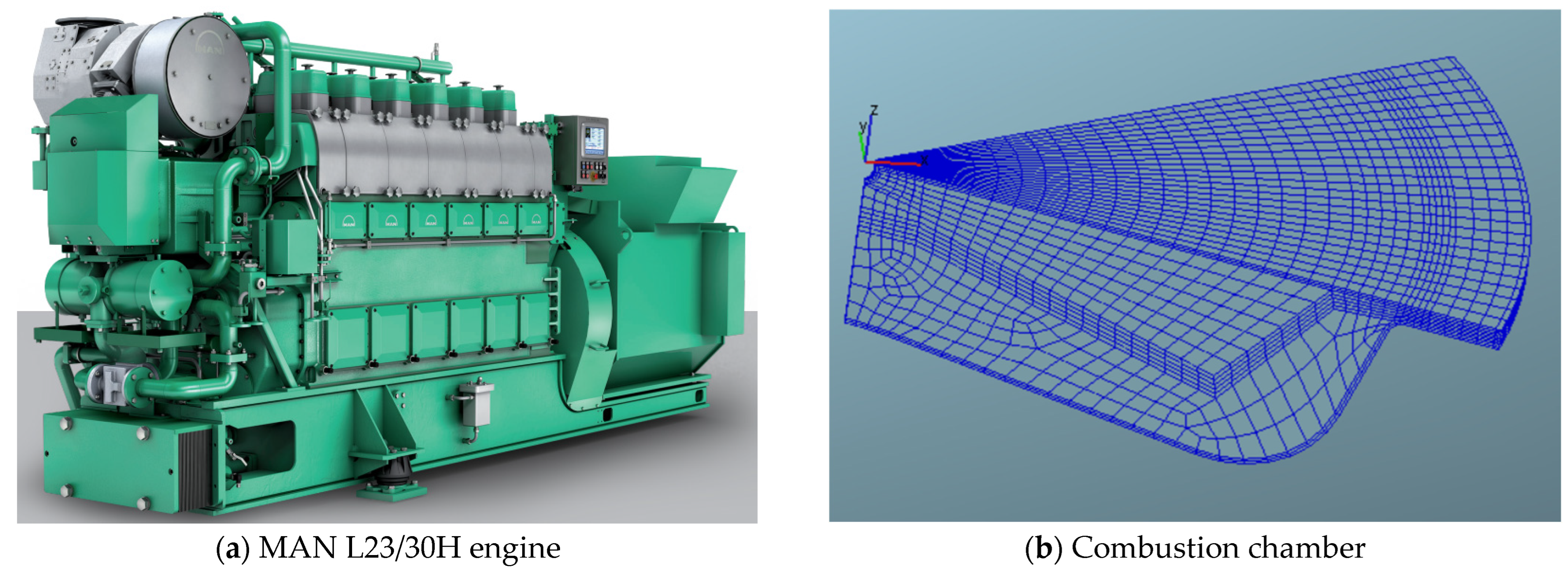

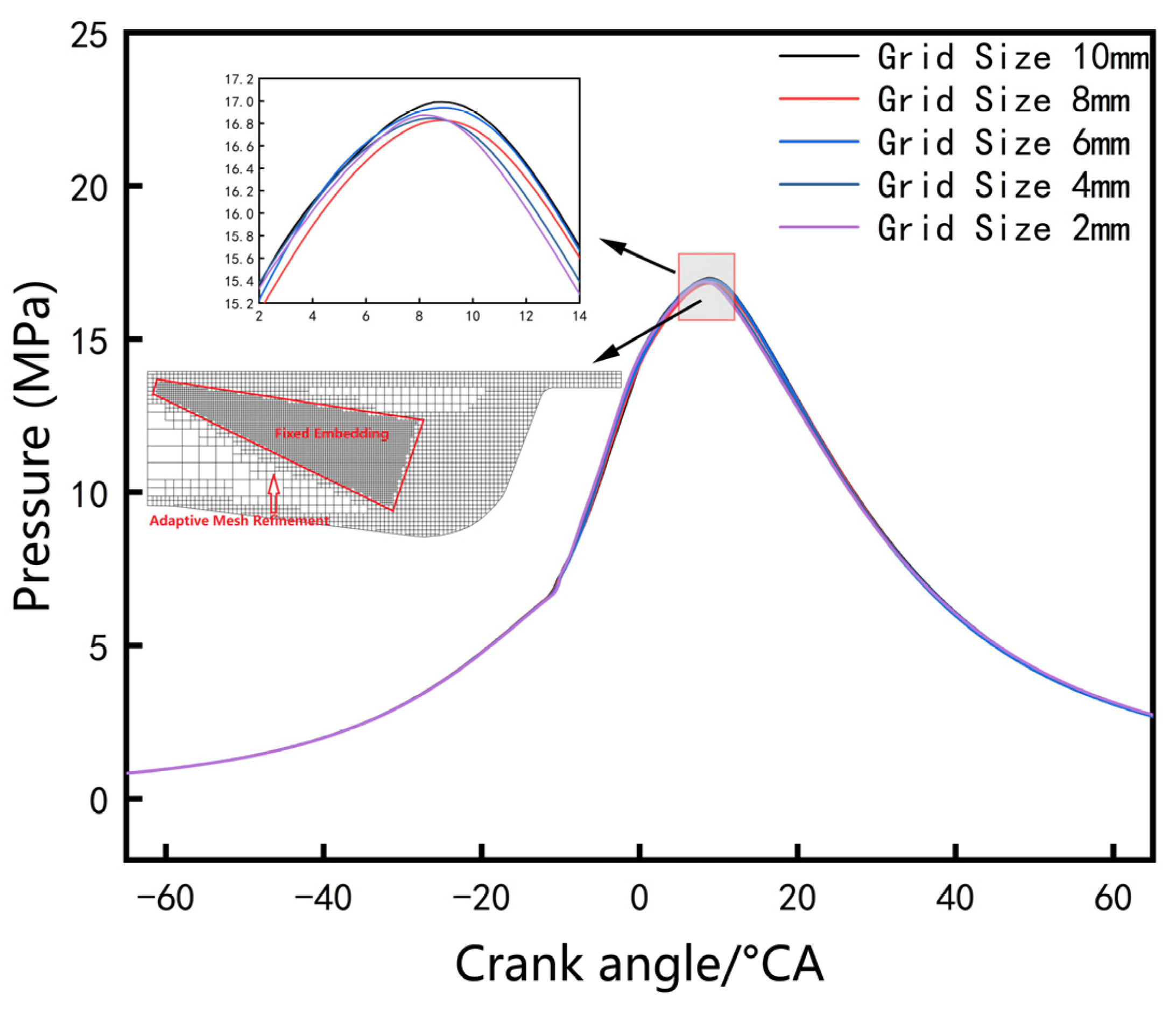



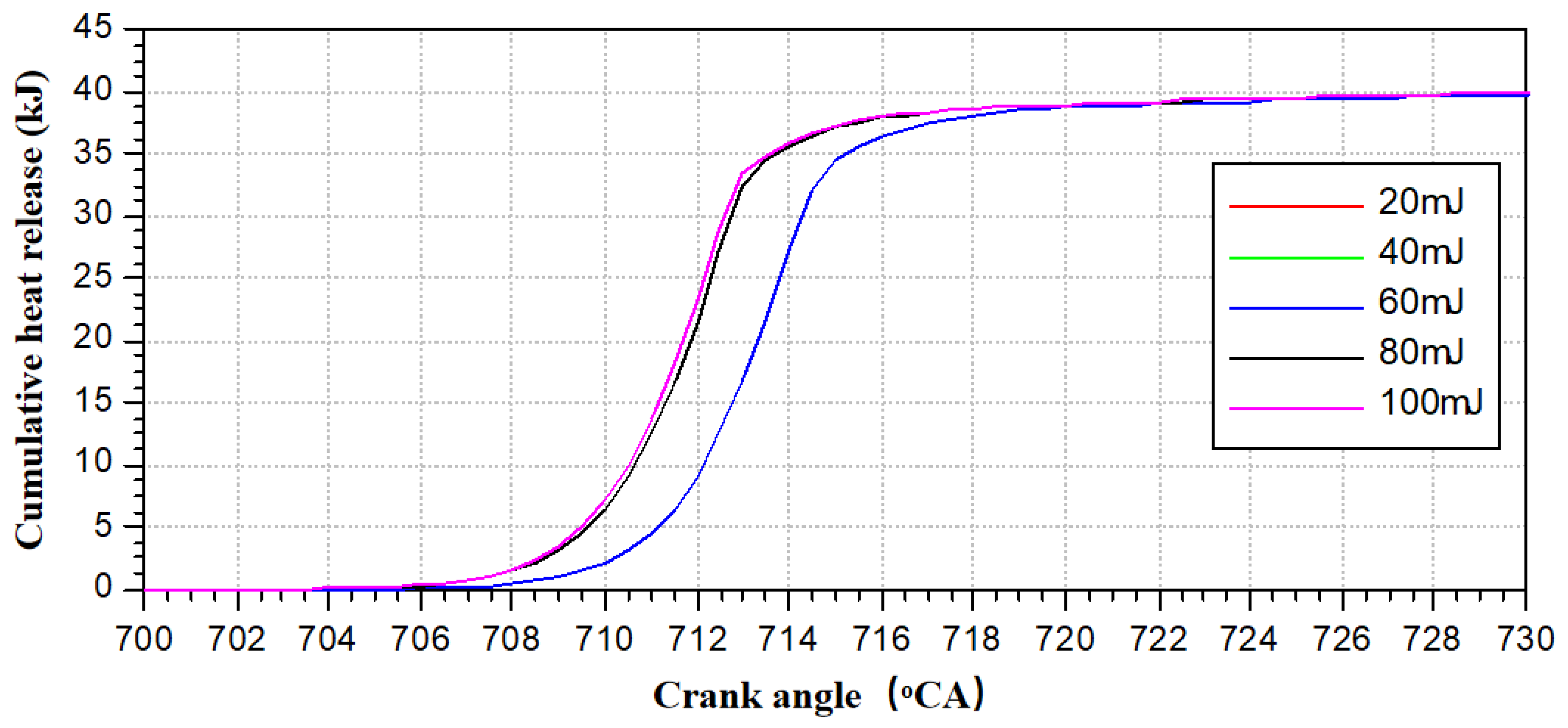
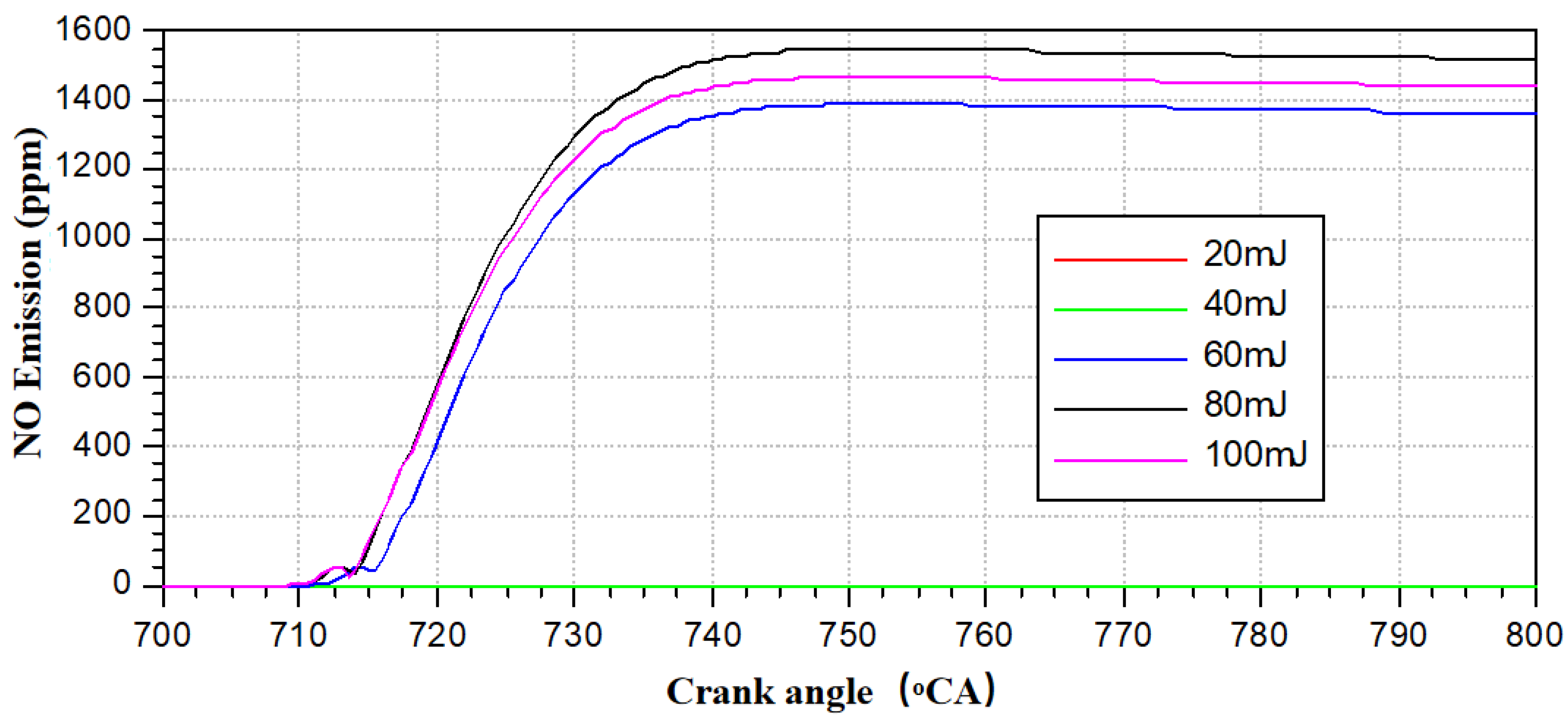
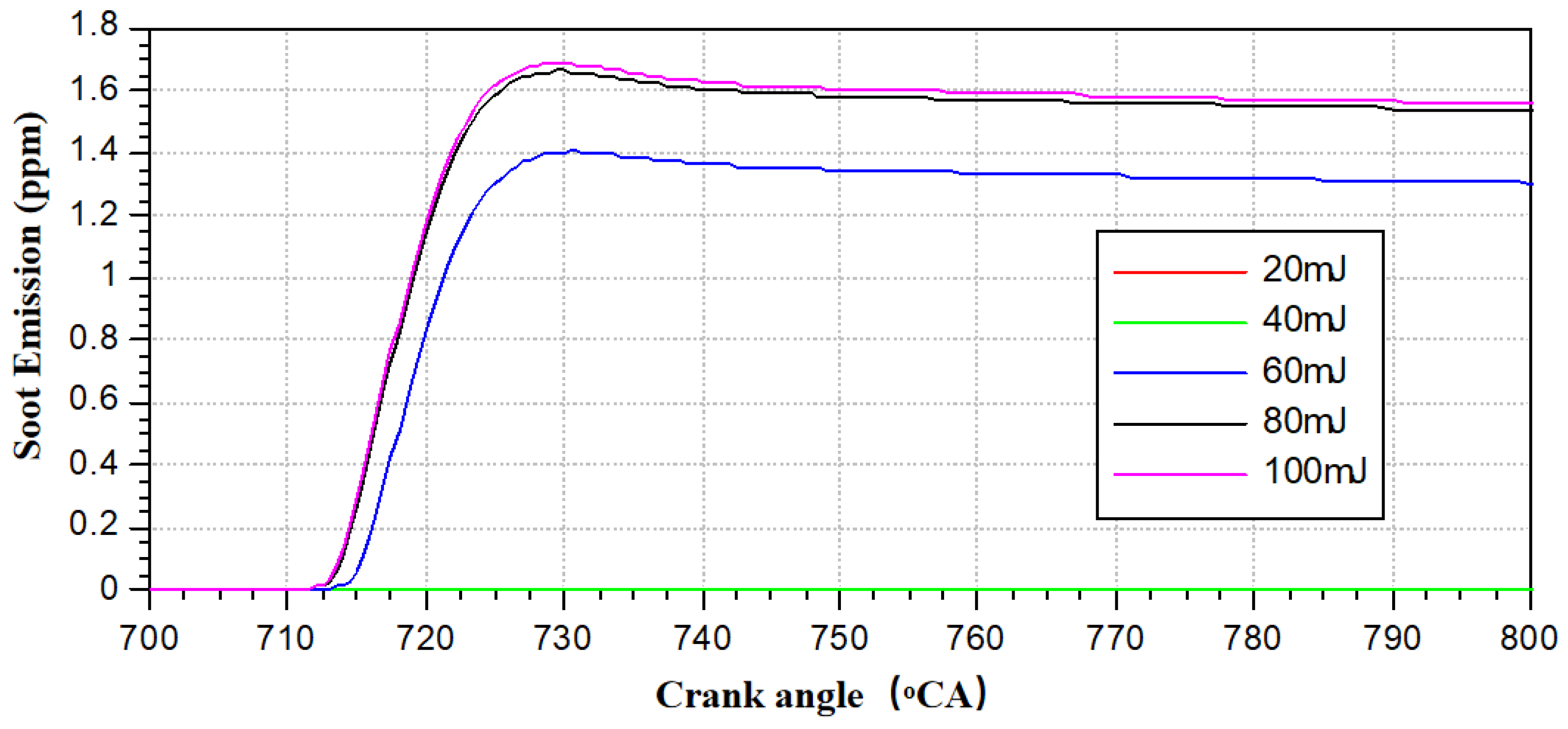
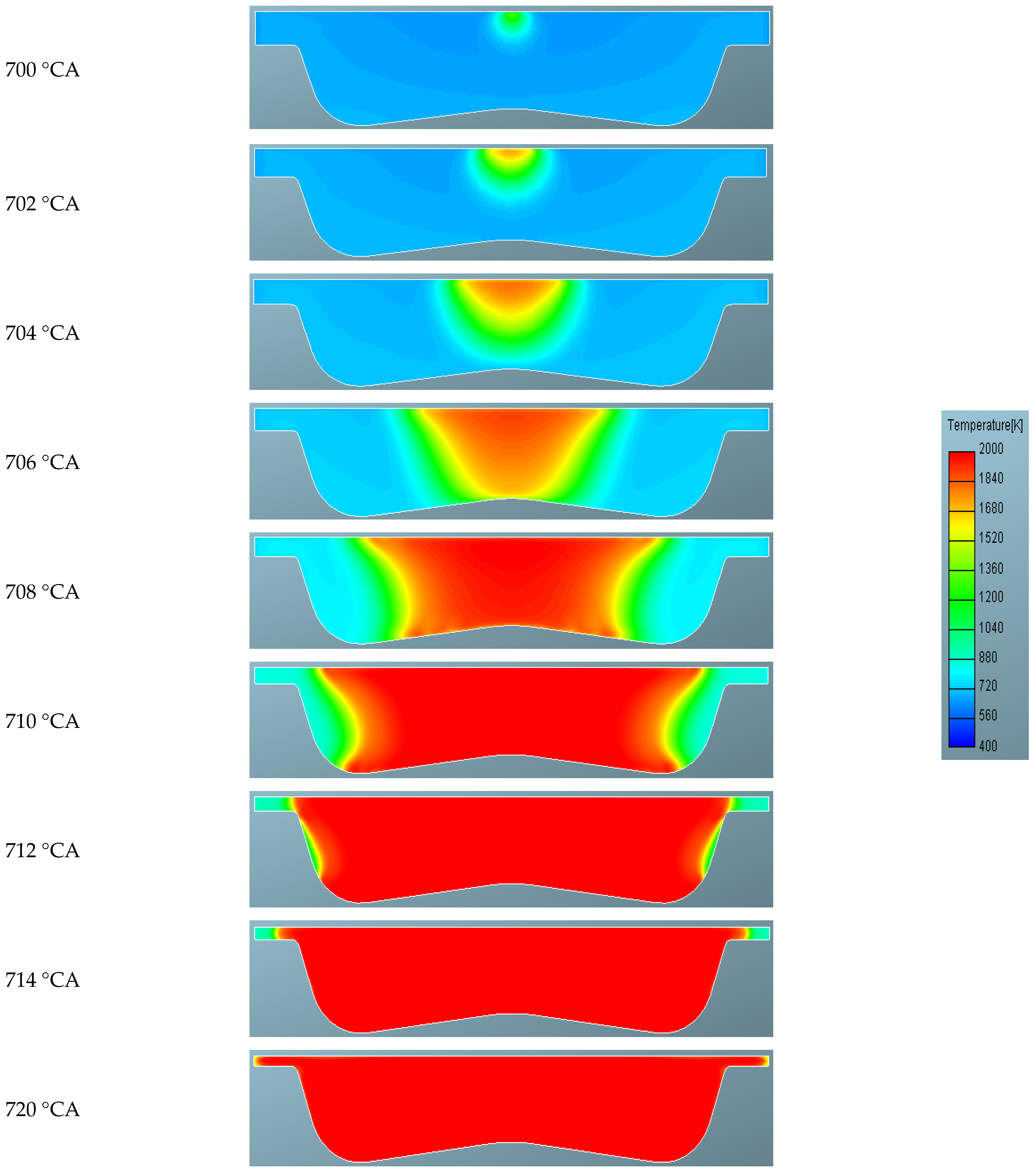

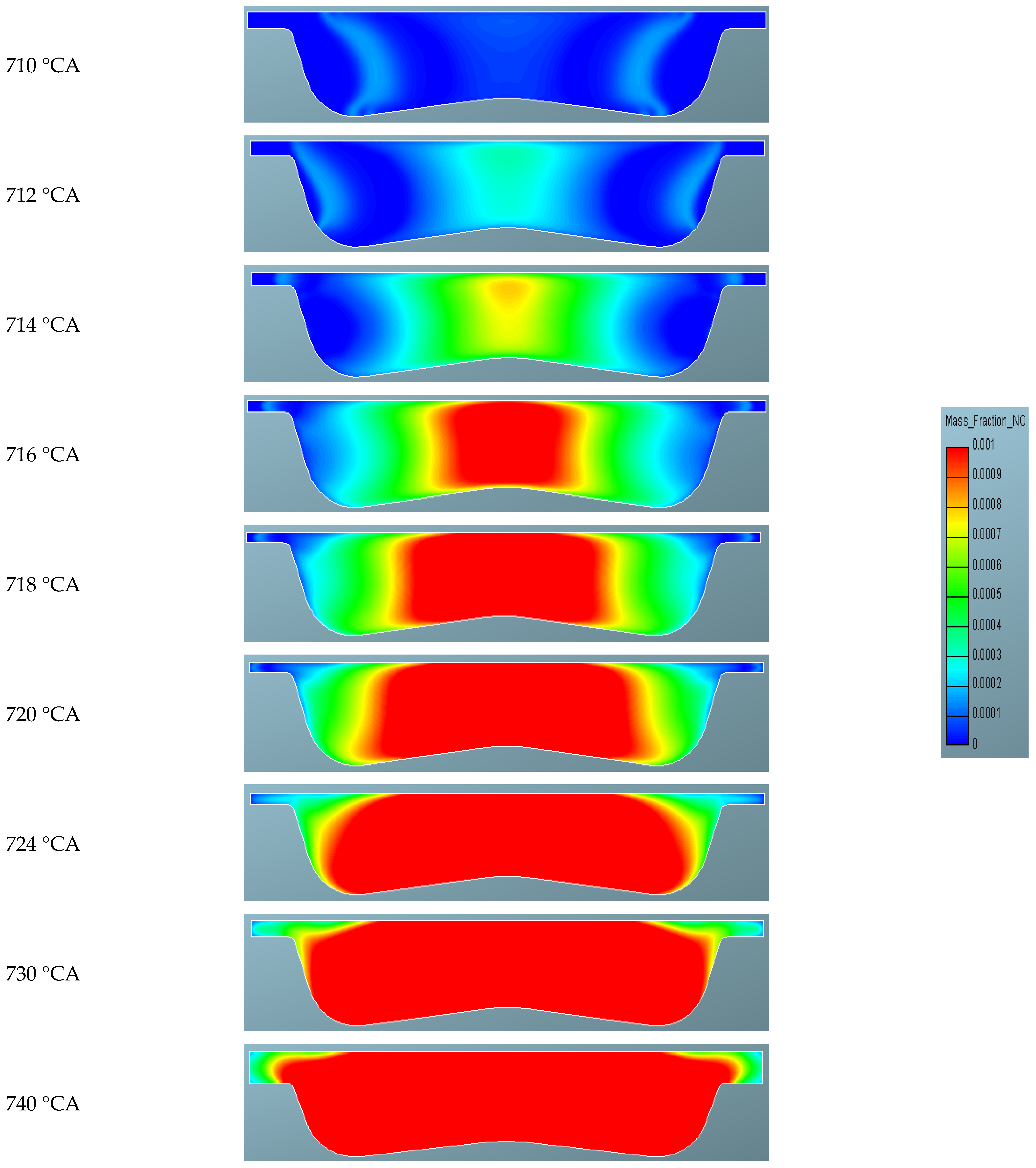

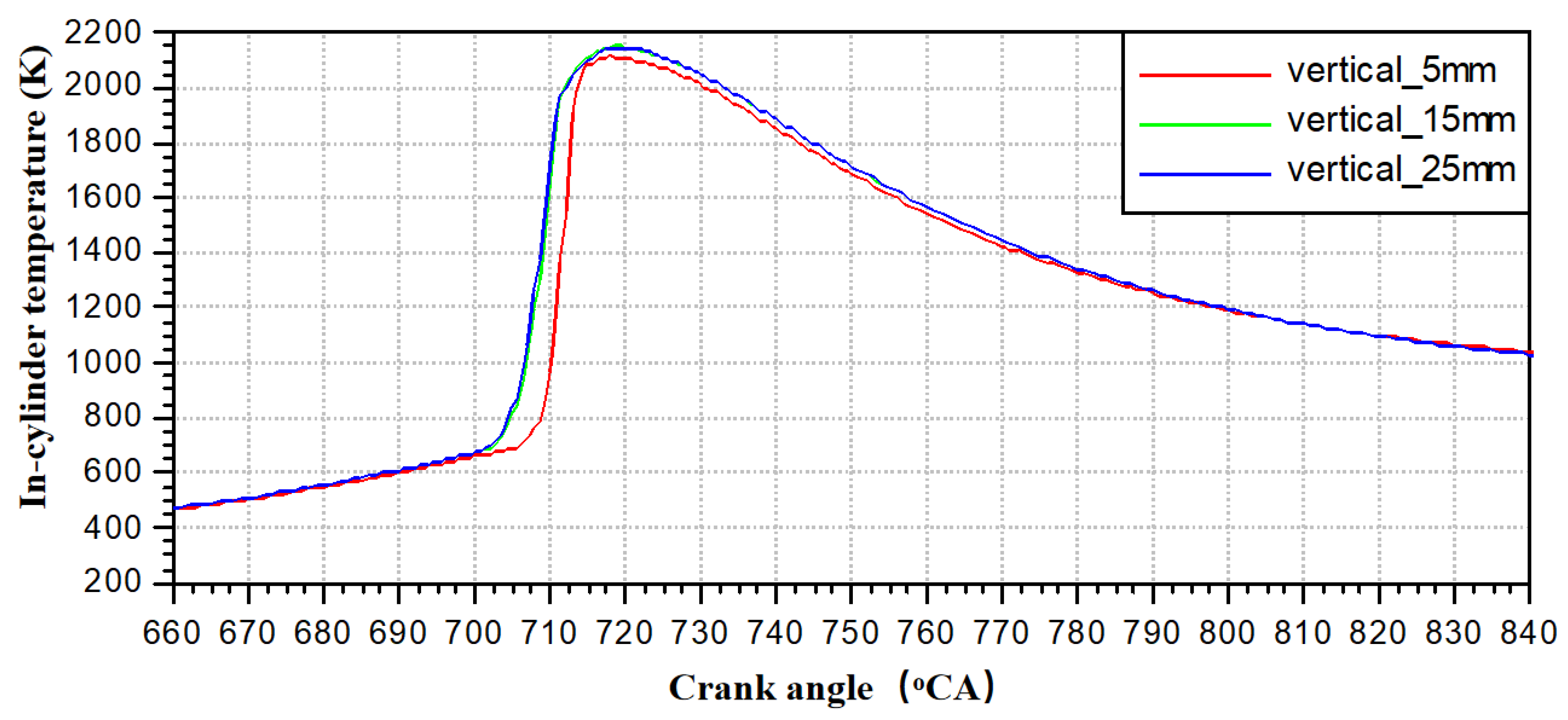
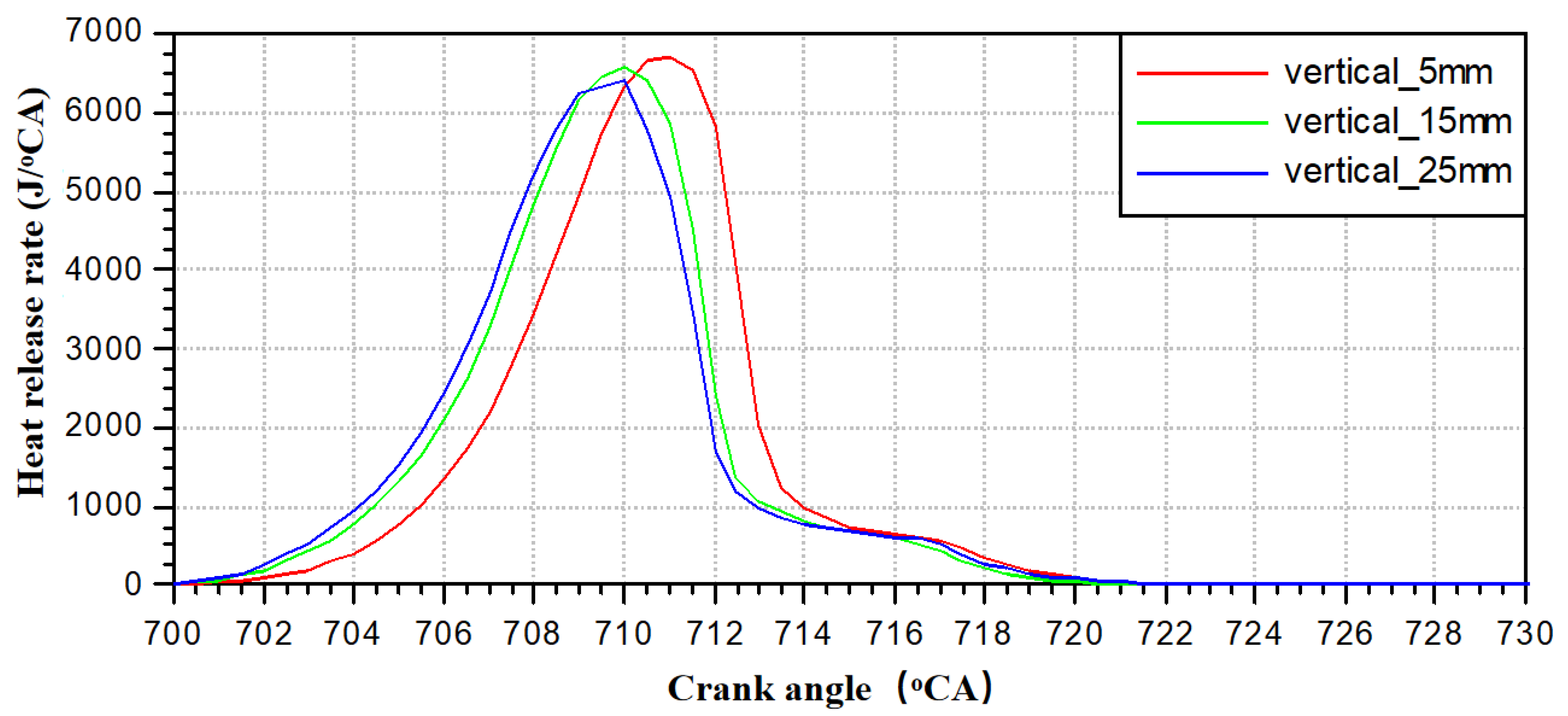
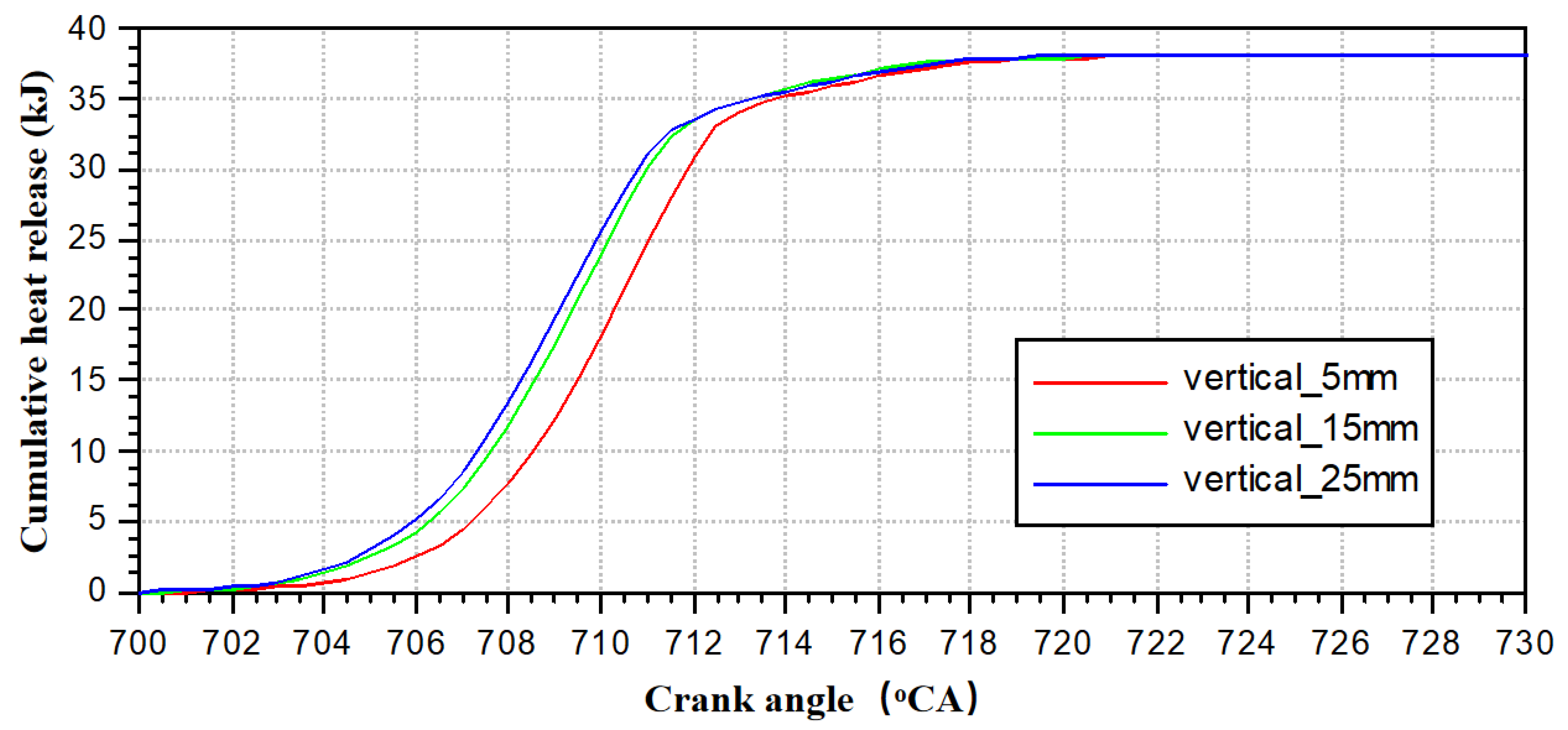
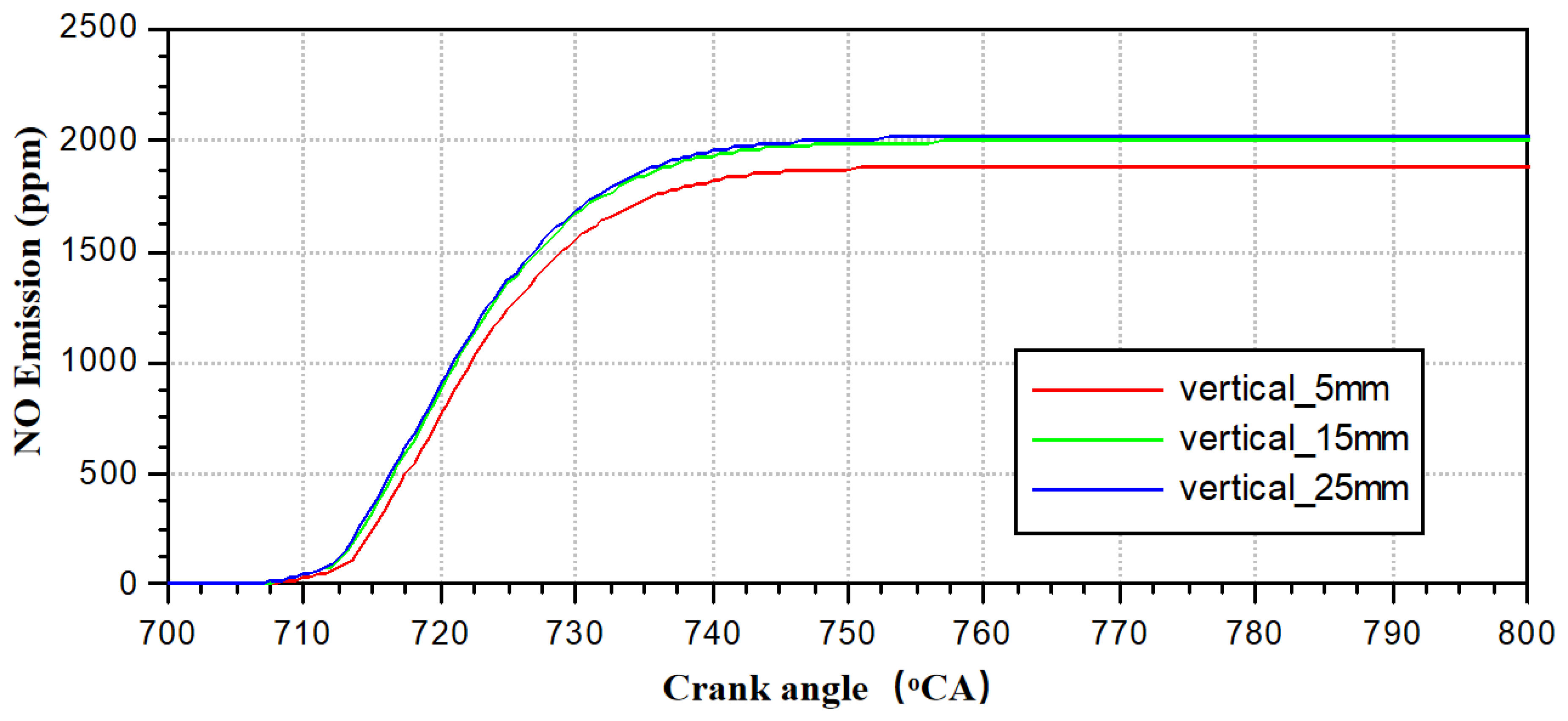
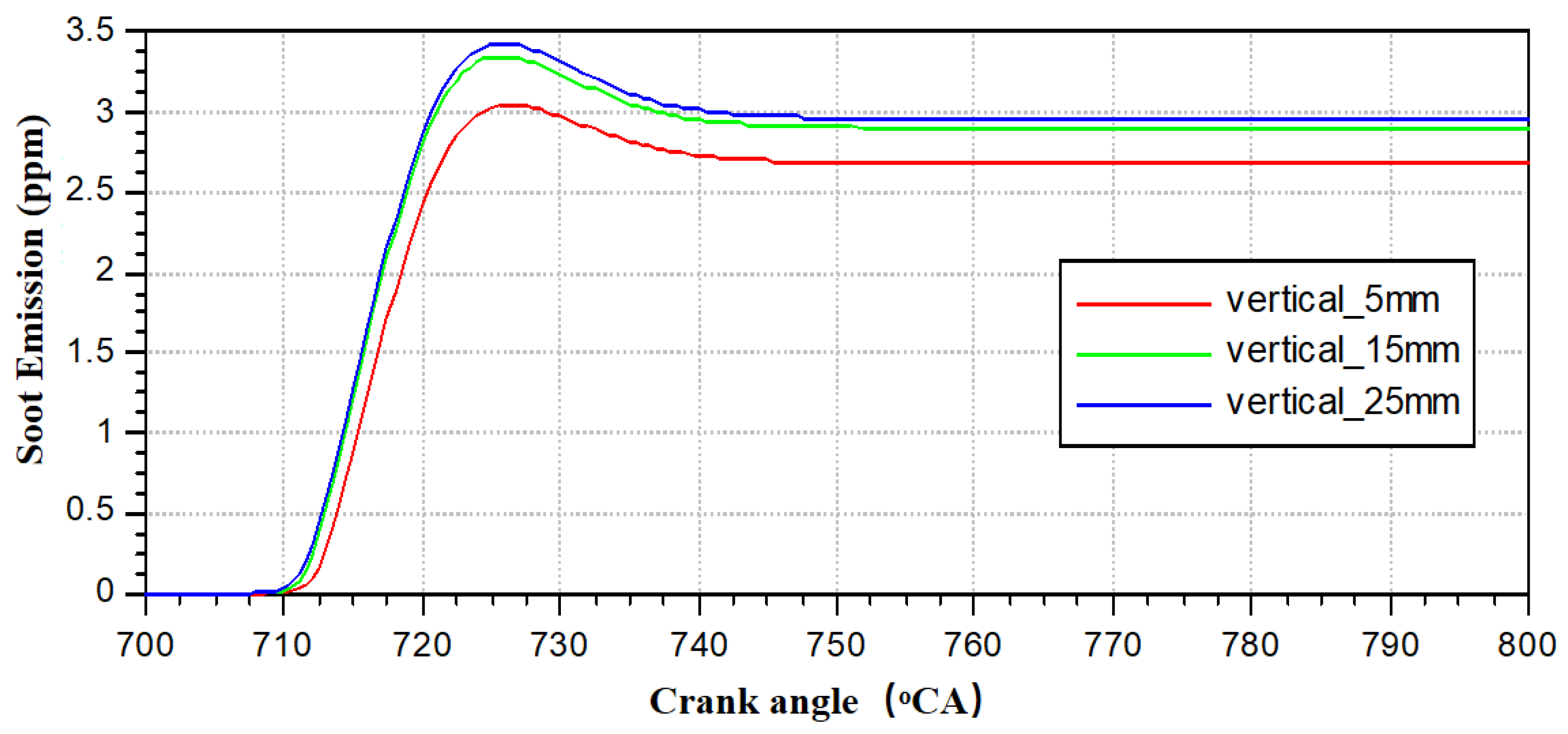

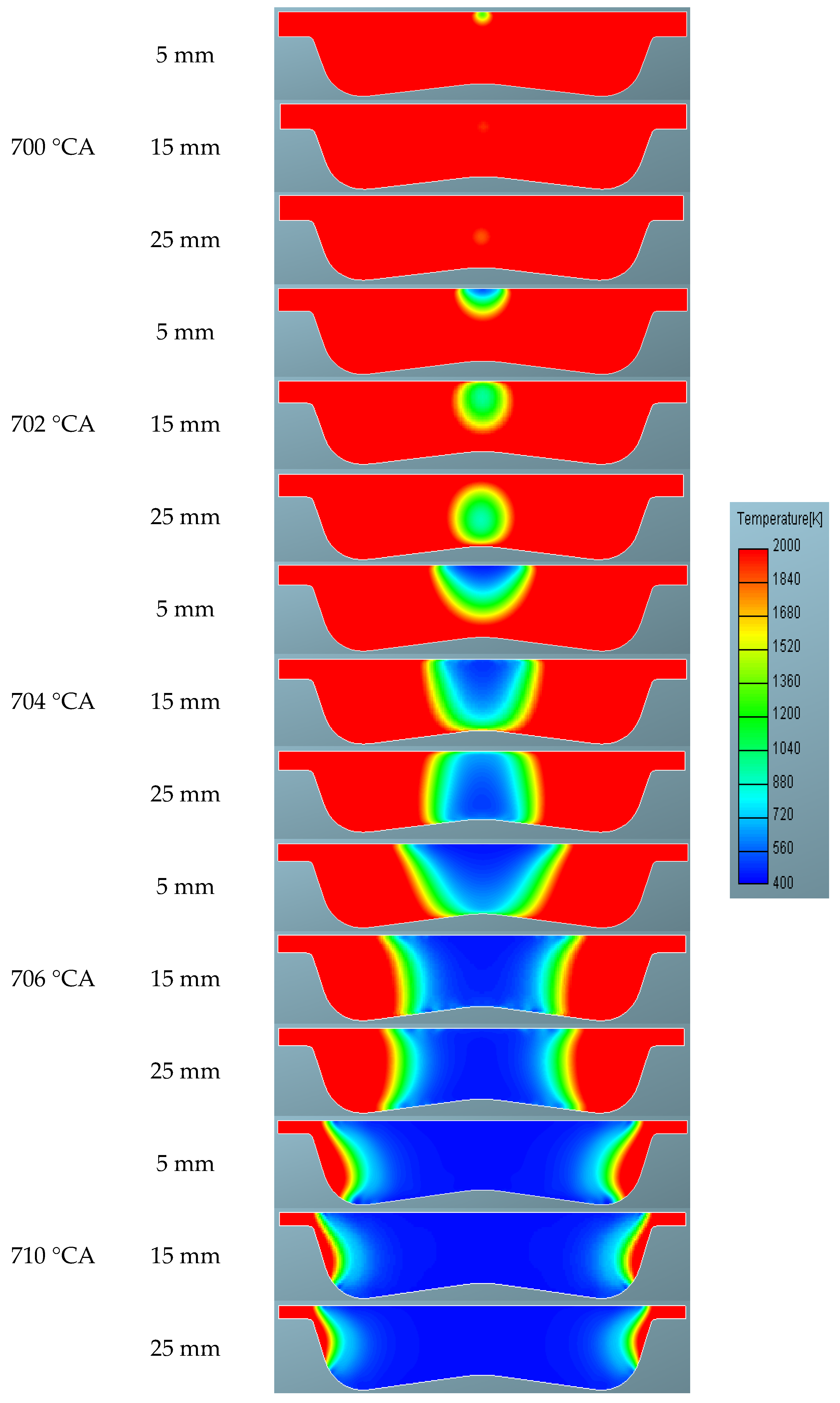
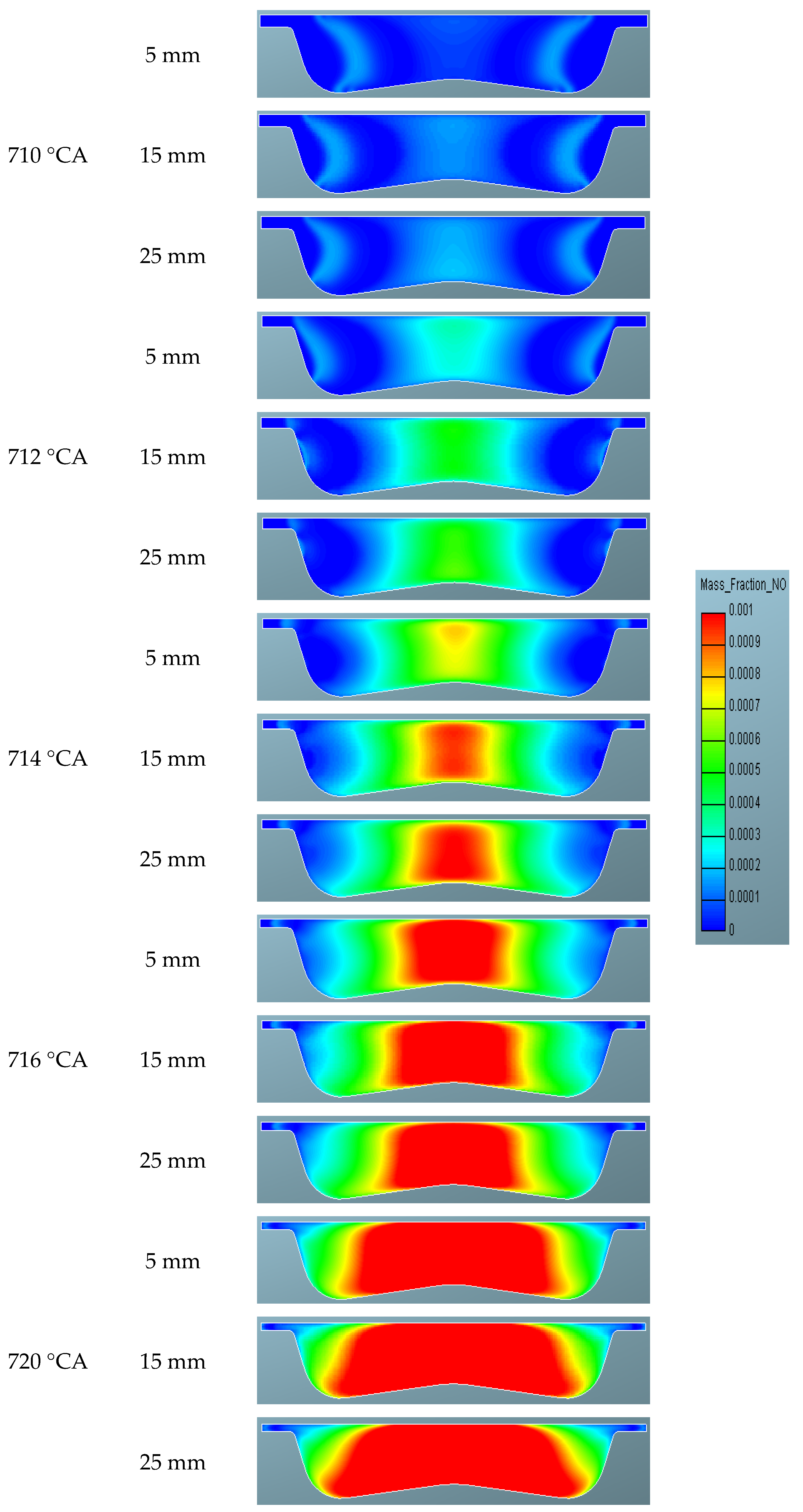
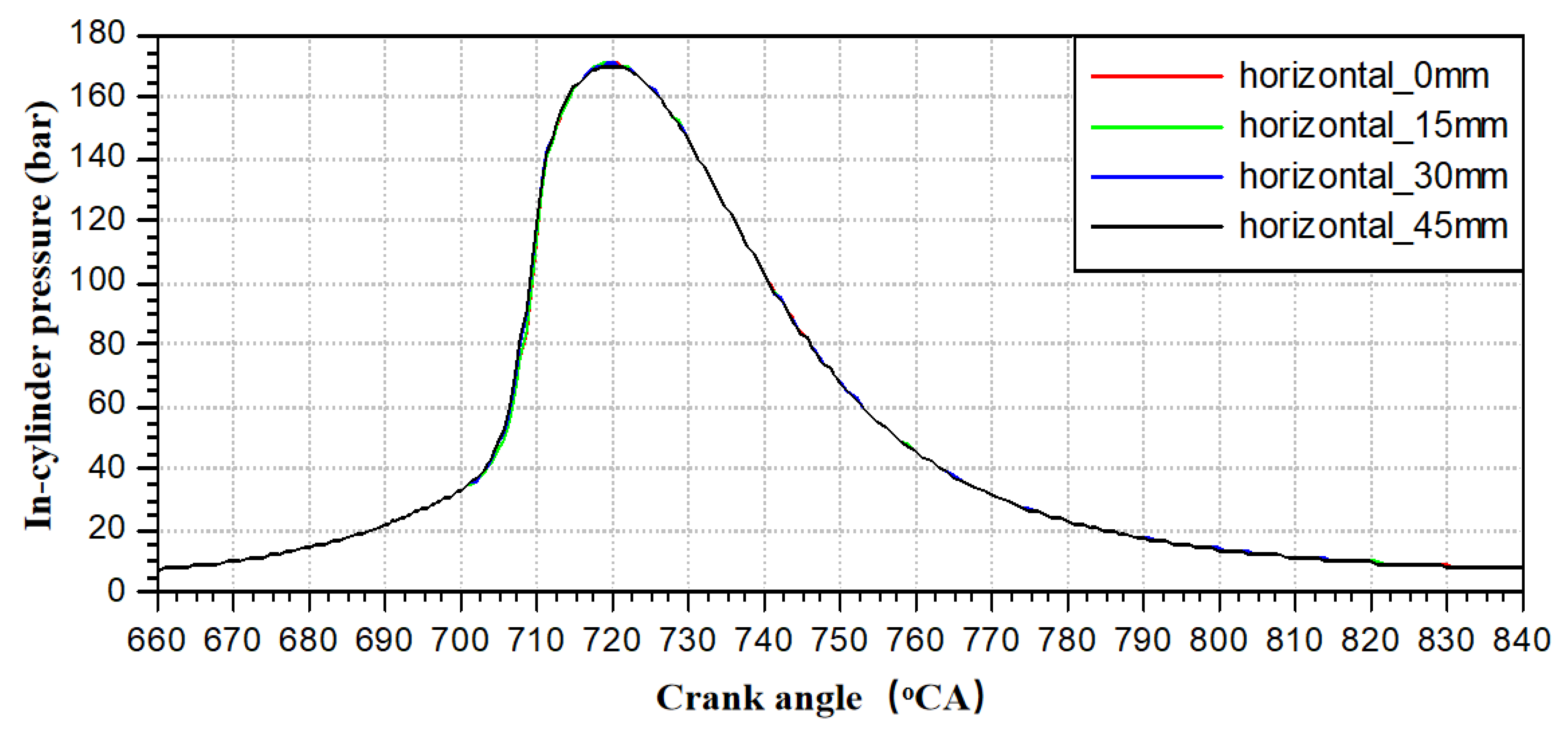
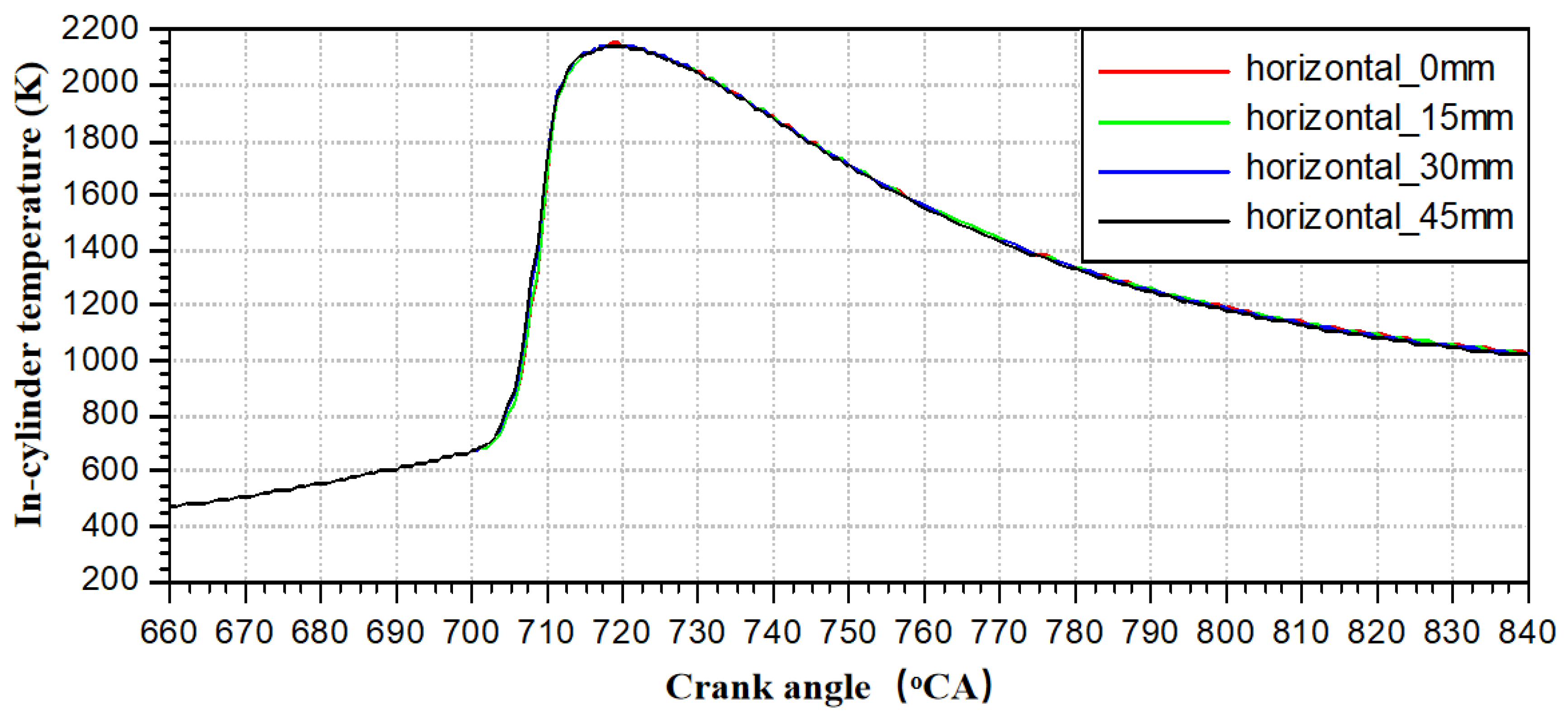
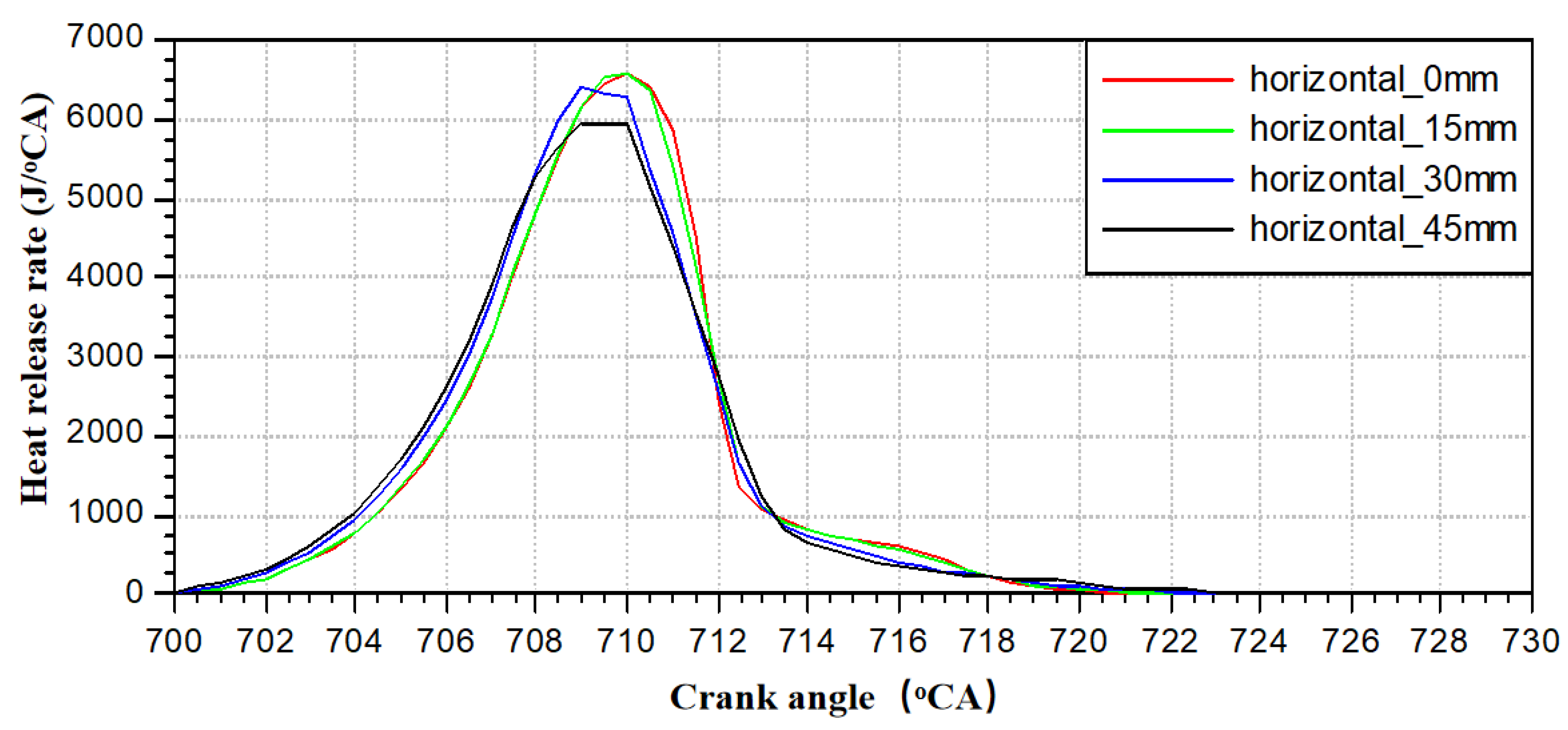
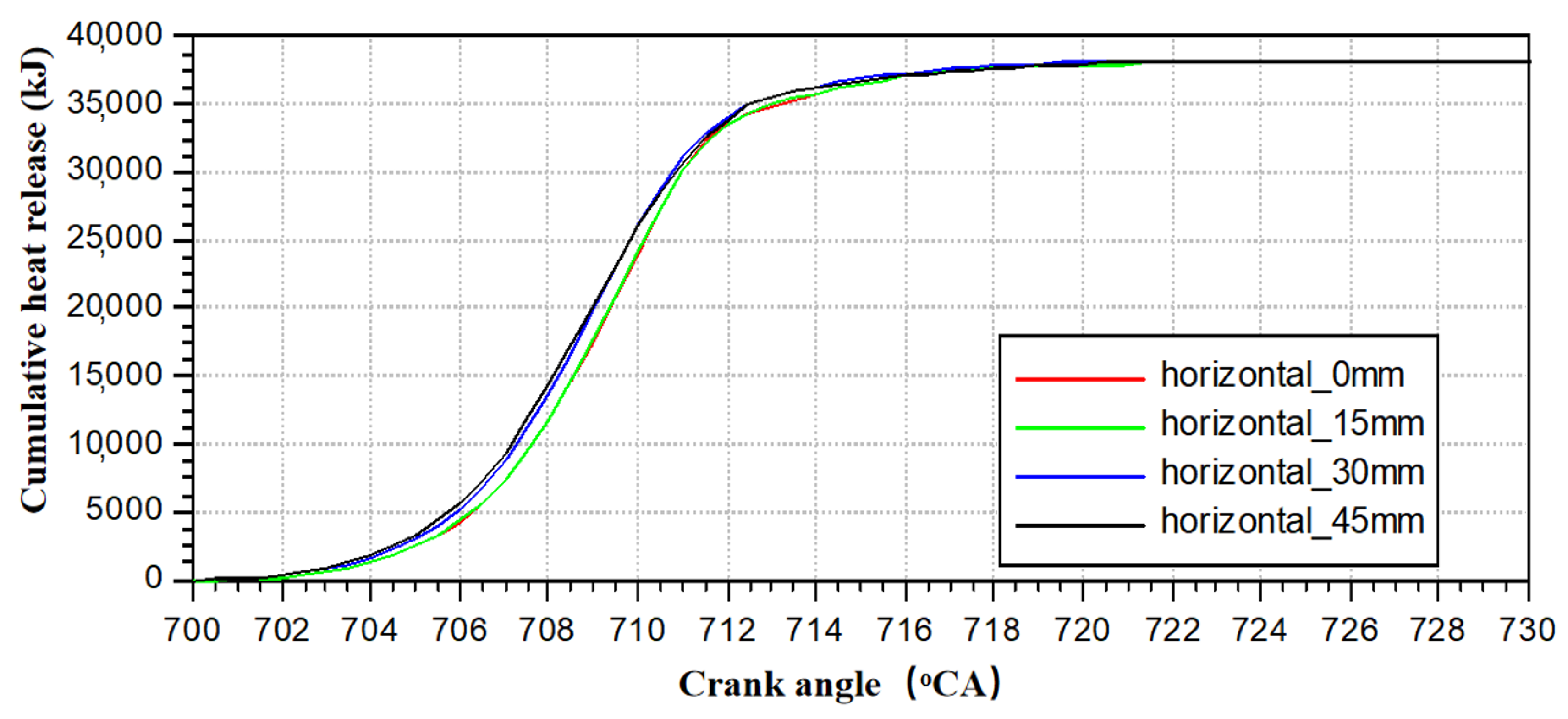
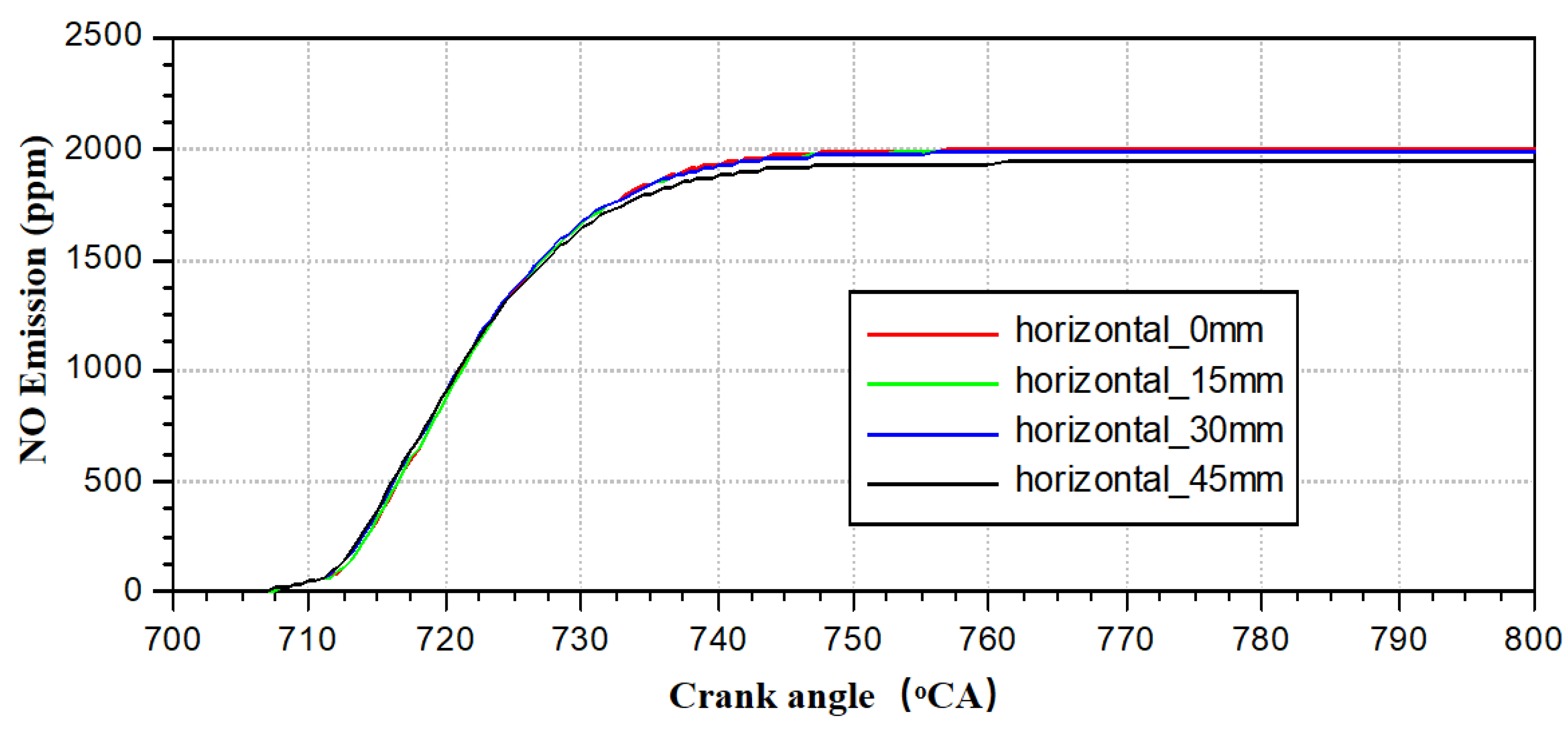
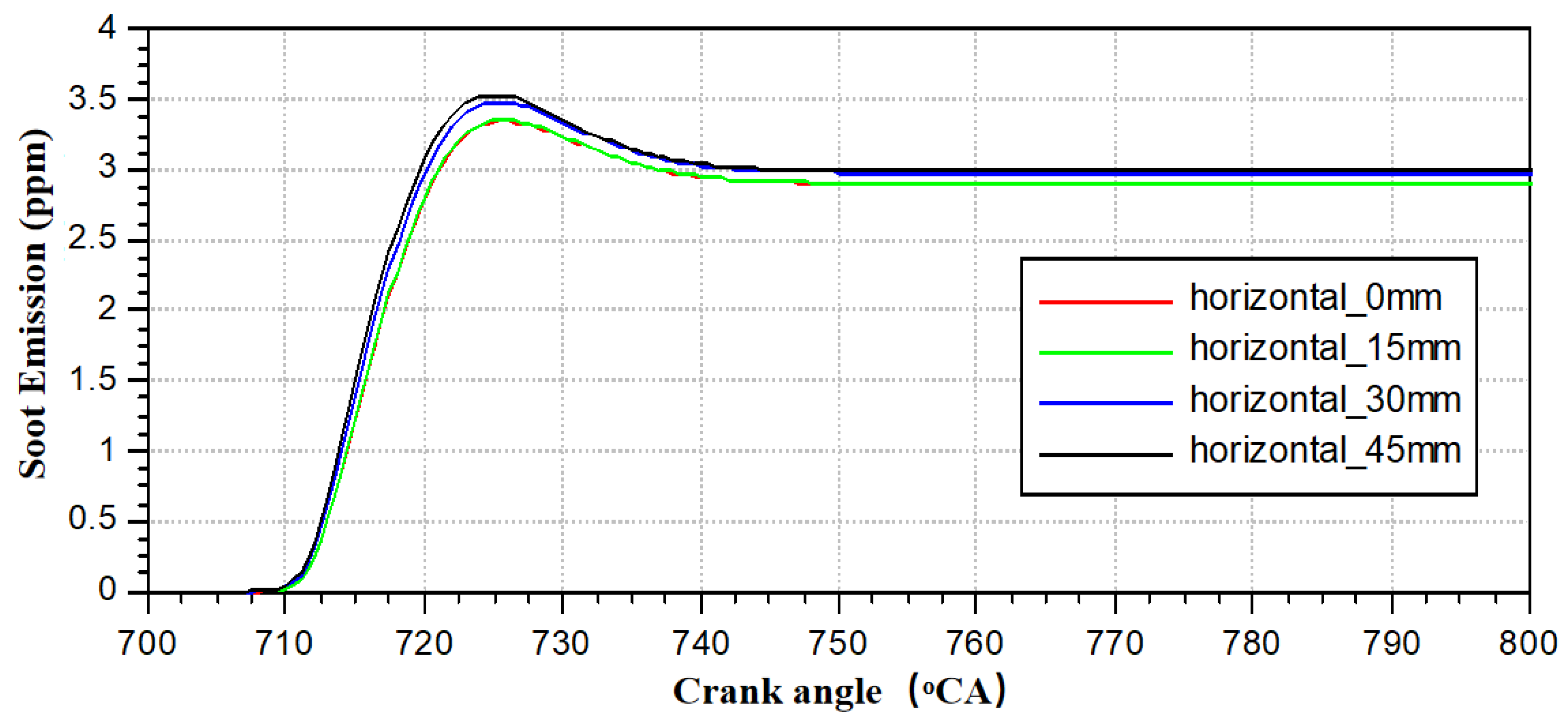

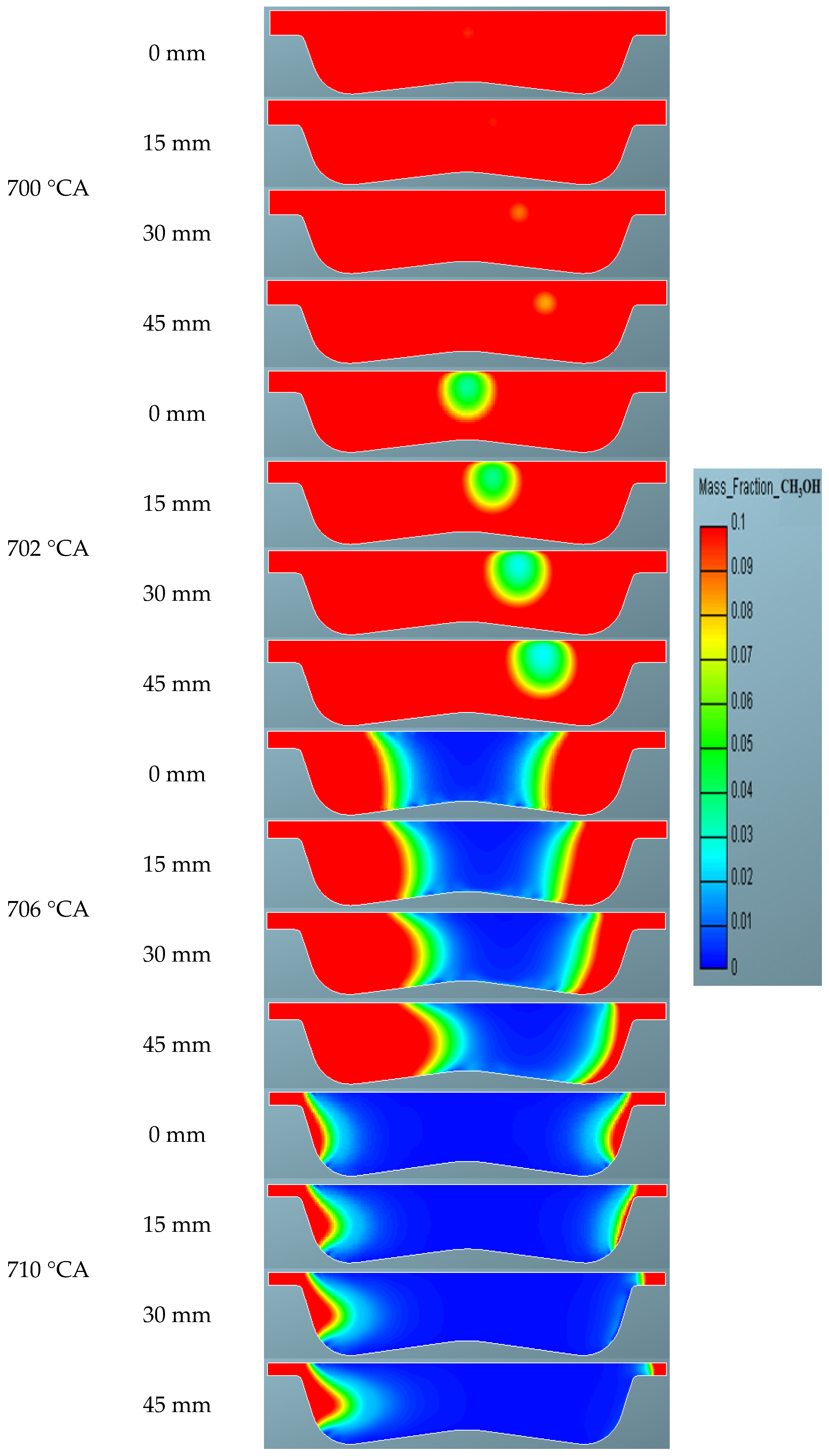
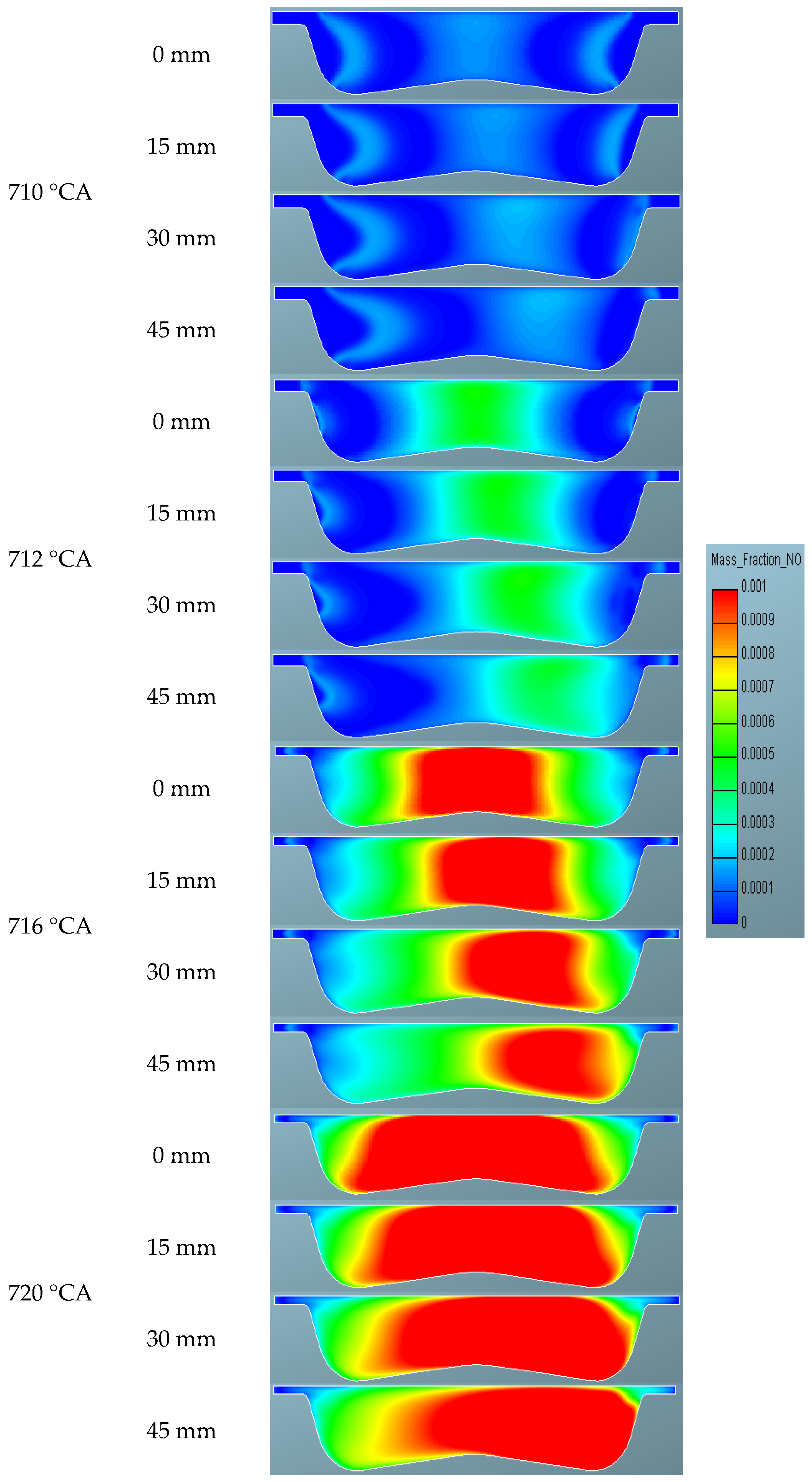
| Parameter | Value |
|---|---|
| Cylinder diameter | 225 and 300 mm |
| MCR Output | 175 kW |
| MCR rotational speed | 900 rpm |
| Compression Ratio | 13.6 |
| Piston area per cylinder | 398 cm2 |
| Piston velocity | 9 m/s |
| Swept volume during piston operation | 11.8 L |
| MCR fuel consumption | 194 g/kWh |
| IMEP | 19.7 bar |
| MCP | 151 bar |
| Physical Model Name | Submodel Settings |
|---|---|
| Turbulence model | RNG k-ε [15] |
| Spray breakup model | KH-RT [16] |
| Wall heat transfer model | Han and Reitz model [17] |
| Spray collision model | NTC collision [18] |
| Drop turbulent dispersion model | Wall Film-O’Rourke [19] |
| Combustion model | SAGE [20] |
| Carbon smoke emission model | Hiroyasu soot [21] |
| NOx formation model | Extended Zeldovich [22] |
| Number | Laser Energy (mJ) | Laser Longitudinal Position (mm) |
|---|---|---|
| 1 | 20 | 5~6 |
| 2 | 40 | 5~6 |
| 3 | 60 | 5~6 |
| 4 | 80 | 5~6 |
| 5 | 100 | 5~6 |
| … | … | … |
| Number | Laser Energy (mJ) | Laser Longitudinal Position (mm) |
|---|---|---|
| 1 | 80 | 5~6 |
| 2 | 80 | 15~16 |
| 3 | 80 | 25~26 |
| … | … | … |
| Number | Laser Energy (mJ) | Laser Transverse Position (mm) |
|---|---|---|
| 1 | 80 | 0 |
| 2 | 80 | 15 |
| 3 | 80 | 30 |
| 4 | 80 | 45 |
| … | … | … |
Disclaimer/Publisher’s Note: The statements, opinions and data contained in all publications are solely those of the individual author(s) and contributor(s) and not of MDPI and/or the editor(s). MDPI and/or the editor(s) disclaim responsibility for any injury to people or property resulting from any ideas, methods, instructions or products referred to in the content. |
© 2025 by the authors. Licensee MDPI, Basel, Switzerland. This article is an open access article distributed under the terms and conditions of the Creative Commons Attribution (CC BY) license (https://creativecommons.org/licenses/by/4.0/).
Share and Cite
Liu, X.; Zhu, J.; Wang, Z. Study on Cold Start of Methanol Direct Injection Engine Based on Laser Ignition. Energies 2025, 18, 2119. https://doi.org/10.3390/en18082119
Liu X, Zhu J, Wang Z. Study on Cold Start of Methanol Direct Injection Engine Based on Laser Ignition. Energies. 2025; 18(8):2119. https://doi.org/10.3390/en18082119
Chicago/Turabian StyleLiu, Xiaoyu, Jie Zhu, and Zhongcheng Wang. 2025. "Study on Cold Start of Methanol Direct Injection Engine Based on Laser Ignition" Energies 18, no. 8: 2119. https://doi.org/10.3390/en18082119
APA StyleLiu, X., Zhu, J., & Wang, Z. (2025). Study on Cold Start of Methanol Direct Injection Engine Based on Laser Ignition. Energies, 18(8), 2119. https://doi.org/10.3390/en18082119





